Ukrainian Scientists and Educators in Wartime
By Olha Harmatiy
Researchers are standing up for the country’s independence, and for a free and educated nation.
Researchers are standing up for the country’s independence, and for a free and educated nation.

On July 5, Ukrainian Maryna Viazovska became the second woman in history to win the Fields Medal, the world’s most prestigious honor for young mathematicians, for her innovative work on sphere packing. Viazovska was born and brought up in Kyiv, the capital of Ukraine, and graduated from Taras Shevchenko National University. She has worked since 2016 at the Federal Polytechnic School of Lausanne in Switzerland.
Now Viazovska, like many other Ukrainians, is housing family members fleeing the war, while she also mourns the mounting losses in her homeland. More than 6.6 million residents have been forced to flee the country. Viazovska’s two sisters and their children, ages eight and nine, arrived on March 4 in Lausanne to stay with the mathematician and her husband and two children. Meanwhile, other family members, including Viazovska’s parents and her 85-year-old grandmother, decided to remain in Kyiv, much to the professor’s dismay. Even those who were fortunate enough to be living elsewhere as the violence erupted have not been spared the ongoing fears of what is happening to their homeland and loved ones. Viazovska told Quanta Magazine in July, “I cannot work when I’m in conflict with somebody or there is some emotionally difficult thing going on.” In an interview in July with Public Broadcasting of Ukraine, Viazovska said that she knows colleagues who put away their books and went to fight at war or become volunteers, including some who have died.
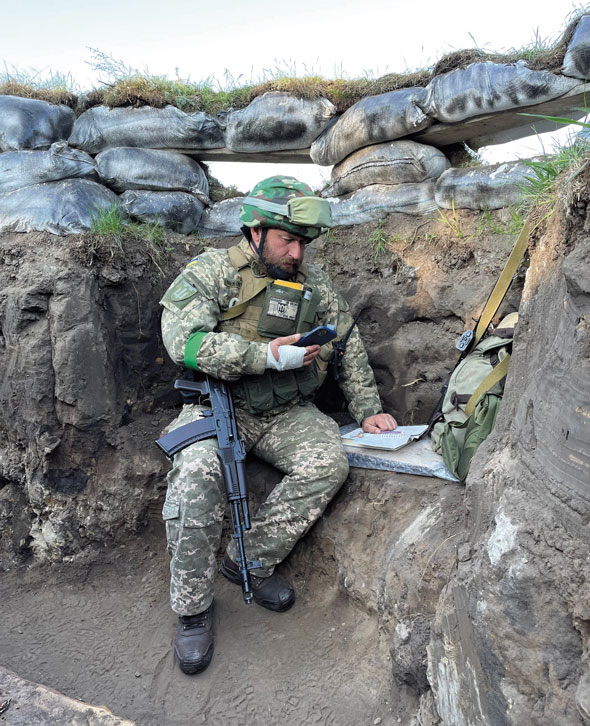
Victor Shchadey, Armed Forces of Ukraine
Indeed, Ukrainians who decided to stay in the country are in mortal danger. Many Ukrainian scientists—an unknown number—are among them. The full-scale war against Ukraine that Russia escalated on February 24 has killed Ukrainians in the tens of thousands so far, including hundreds of children and thousands of civilians. The war has destroyed all spheres of Ukrainian social life, caused enormous damage to the country’s science, and left a deep destructive imprint on the educational sphere. [Editor’s note: In this article, the words Russia and Russian are capitalized in accordance with the publication’s grammatical style, but the author notes that many Ukrainians, as a way of indicating resistance to Russian aggression, now refuse to capitalize those words and other proper names associated with the aggression.]
Most of the estimated 79,000 researchers who lived and worked in the country before the war, as well as the far greater number of students they mentored and taught, have been displaced, killed, or involved in war efforts. The Russian state is an aggressor that perceives the statehood of Ukraine as an existential threat and is waging war against the Ukrainian people, against Ukrainian culture, history, and science. In response, Ukrainian scientists are standing up for their right to work in a free and democratic society by building new alliances, helping to defend the country and save lives, and learning lessons that might someday aid healing and rebuilding.
From the first days of the full-scale invasion in late February, objects of scientific and educational infrastructure were among the targets of Russian shelling. Numerous buildings of scientific institutions and objects of research infrastructure were destroyed, and equipment and laboratories were lost. And there are currently many scientists and institutions in territories that are now controlled by Russia.
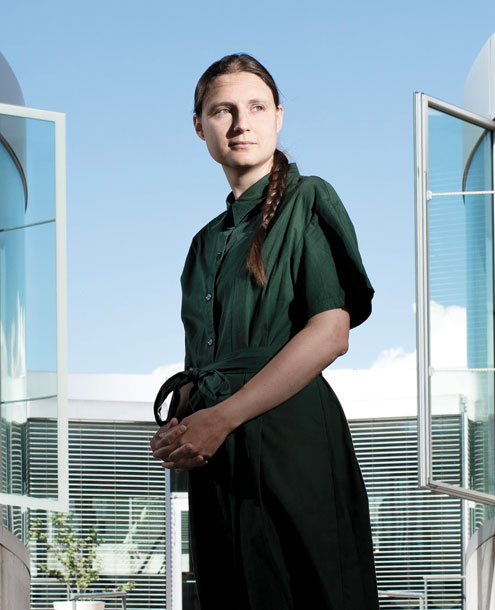
Fred Merz/AP Images
Russian forces continue to deliberately direct missile strikes at Ukrainian educational and scientific establishments. Institutions in the Donetsk and Luhansk regions, in Kyiv, Mariupol, Kharkiv, Sumy, Mykolaiv, Zaporizhzhia, Chernihiv, Kherson, and other Ukrainian cities, have suffered most from the attacks of the Russian occupiers. It has not yet been possible to assess all the damage, because shelling and rocket attacks continue. Personal residences of employees of scientific and educational institutions have been damaged and destroyed as well, so many people have nowhere to live.
The Ministry of Education and Science of Ukraine has created a website with an interactive map of the destruction, which provides data on the losses to educational institutions as a result of the Russian invasion. But the damage is mounting faster than the website’s moderators have time to update the information on the map. Even these incomplete statistics show how badly the educational infrastructure of Ukraine has suffered: As of September 21, the site has recorded 2,528 educational institutions that have been damaged by bombing and shelling, and 285 that have been ruined completely.
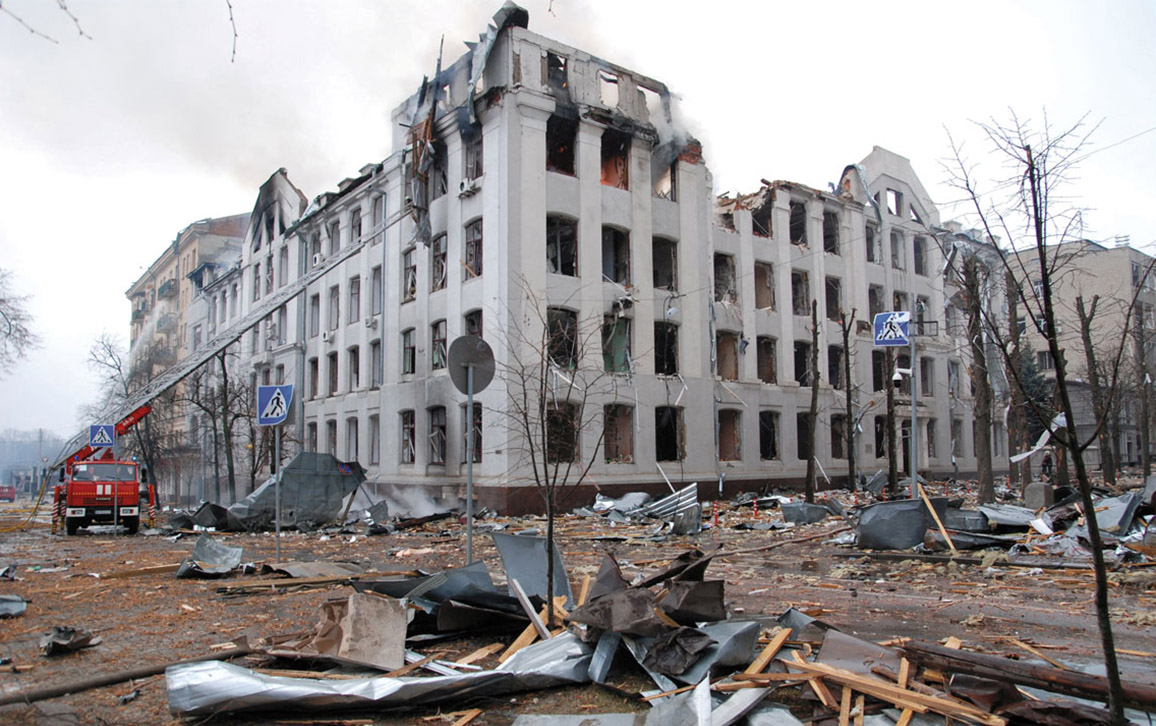
REUTERS/Oleksandr Lapshyn
Many Ukrainians fight in the war, because the alternative of Russian occupation would mean death. The war is not only affecting the overall direction of scientific research, but it is also changing the lives of scientists themselves. Many scientists now serve in the Armed Forces of Ukraine, have joined the militia reserve called the Territorial Defense Forces, or have become volunteers.
Ivan Patrylak, dean of the faculty of history of Taras Shevchenko National University of Kyiv and chairman of the Academic Council of the Center for Liberation Movement Studies, fights with weapons in his hands. His military nickname is “Dean.” Now he is making history, not just researching it, according to Andriy Kovalov, press officer of the 112th Territorial Defense Brigade of the Armed Forces of Ukraine.
In civil life, Patrylak is also a researcher, scientific communicator, popularizer of historical knowledge, and author of monographs, textbooks, manuals, and popular and scholarly works about history. Among his main research interests are the history of Ukrainian nationalism and the national liberation movement of the 1920s to the 1950s, including during World War II.
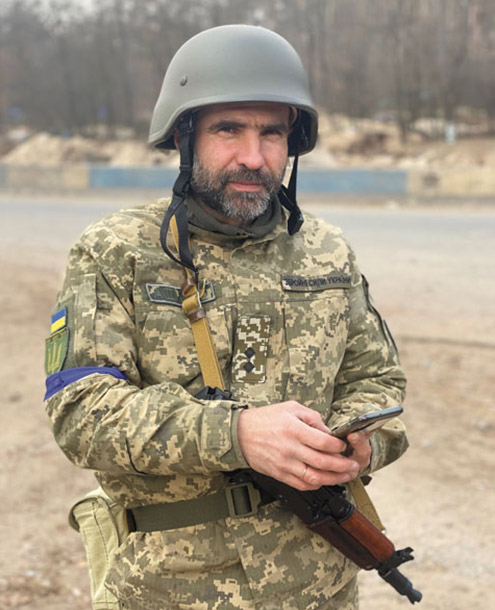
Lieutenant Andriy Kovalov, press officer of the 112th Territorial Defense Brigade of the Armed Forces of Ukraine
Fedir Shandor, head of the sociology and social work department at Uzhhorod National University, has been serving in territorial defense since the first days of the war. In his civilian life, Shandor researches the sociology of religion, tourism, and the phenomenon of national consciousness. He is also the head of the Transcarpathian Regional Tourism Organization, a tourism expert, author, and promoter of many creative initiatives.
In a May 6 article published by his university’s media center, Shandor noted that the schedule of his combat shifts is now adjusted according to his classes. “When I have classes, I am on duty at night,” Shandor said, “and immediately after my shift in the morning I deliver a lesson [translated from Ukrainian by the author].” The professor emphasized: “We are fighting for an educated nation.”
Some scientists have been forced to evacuate from areas of active hostilities. Halyna Kutniakova is a lecturer at the department of social communications of Mariupol State University. With her daughters, she lived in the blockaded Mariupol under conditions of a humanitarian disaster. When a Russian missile destroyed their apartment, they miraculously survived. Then they hid from Russian tanks at the local drama theater, which served as the main communication headquarters for many residents; Kutniakova and her family were among more than 1,300 people who sought shelter there. The family experienced another tragedy on March 16, when Russia dropped a bomb on the theater. At least 300 people died, though no one knows for sure how many people were trapped or killed under the ruins.
“We are fighting for an educated nation.”
Kutniakova and her family escaped Mariupol with great difficulty, leaving the city on foot and taking no belongings—only their cat—with them. On her Facebook page, Kutniakova wrote: “It is wrong to say ‘we lost everything.’ We are fighting for our country and our bright future. We have ourselves, our language and culture.” She also wrote the following: “Everyone . . . should make maximum efforts—double, triple them—in order to destroy our enemies more intensively. We have enough strength for this, because love for our relatives and friends, for our soldiers, and for our Ukraine lives in our hearts.” Kutniakova and her family are now safe in Vilnius, Lithuania. She participates in scientific conferences, tells Ukrainian and international media about her experience, and has testified about Russia’s crimes to human rights organizations, the Prosecutor General of Ukraine, and the Security Service of Ukraine (SSU).
Like Kutniakova, many women scientists have been forced to leave the country and take their young children abroad. Many other Ukrainian scientists, scientific communicators, and university teachers, especially those outside of areas with active combat, are now engaged in volunteer work and charitable activities, such as donating blood for the wounded, making camouflage nets and cloths, helping the army financially, and collecting humanitarian aid, food, and basic necessities for the Ukrainian military and internally displaced persons.
In a survey titled “Ukrainian Researchers in Times of War,” which was conducted by the National Research Foundation of Ukraine in April 2022, the vast majority of the 2,173 participants (72.9 percent) responded “No” when asked if it is now possible to be engaged in research activities to the same extent as in prewar times. Participants listed four main reasons for this inability: feeling unsafe; having work that necessitates presence in a certain location that is currently unavailable; technical reasons, such as constant interruptions of the internet, communication networks, or electricity; and apathy or lack of interest, well-documented responses to stress and trauma.
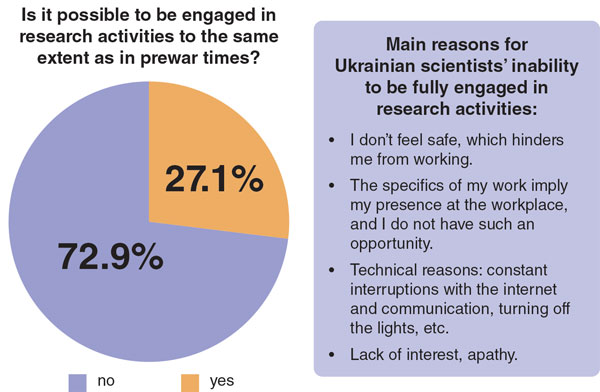
Adapted from National Research Foundation of Ukraine, 2022
Despite these limitations, the academic community fervently believes in the victory of Ukraine and is doing everything possible to achieve it. Scientists are ready to support the country, get to work, and produce results. According to this survey, 74.5 percent of respondents were ready to participate in projects aimed at strengthening defense capabilities and rebuilding Ukraine.
The Ukrainian scientific community has overcome a state of shock and is now starting to pull together to cope with the realities of war. Today, their main task is increasing the defense capability and security of the country.
For instance, researchers from Lviv Polytechnic National University (LPNU) have created combat robots for the Ukrainian army. This project started after the beginning of Russian aggression in 2014. Its goal has been the creation of a military combat unit for use in the Armed Forces. Ukraine has the unfortunate but unique opportunity to test new technologies in real combat conditions. Engineers at LPNU have designed and manufactured a number of different experimental and research mobile robotic platforms, complexes, and their modifications. Their uses include intelligence gathering, demining, transport, security, and training.
The robotic platform Borsuk, for example, performs transport and inspection functions, as well as lifting and cargo operations, and it can mark a dangerous area. Robotic assistant Kesentai was designed to deliver explosive devices to destroy enemy strongholds, vehicles, and other military equipment. It can also be used to remotely observe the enemy’s front line. The robot named Plastun can detect the enemy, observe their actions, scout an area, and perform reconnaissance using a variety of sensors. Other robotic platforms from LPNU specialize in the evacuation of the wounded, the delivery of goods, the use of small firearms, and so on. Inventors are also working on the possibility of using groups of robots as battle swarms.
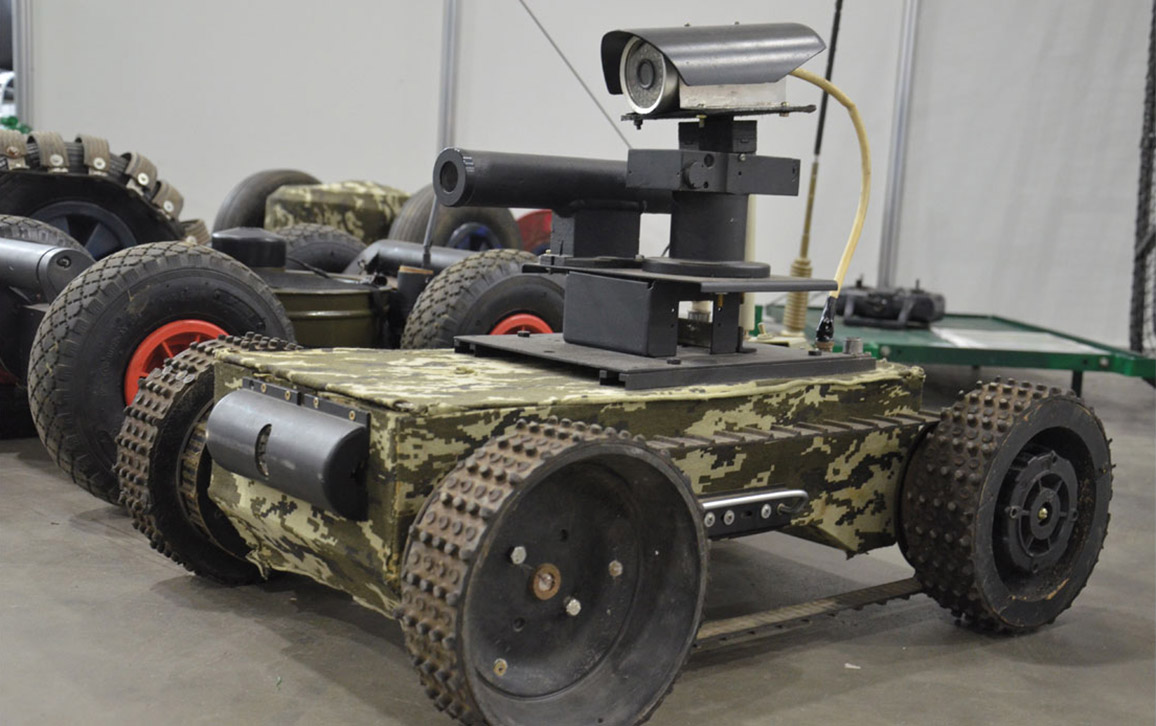
ArmyInform/Mykola Fedorkiv
LPNU has also developed a prototype of a digital gradient meter for high-precision magnetic reconnaissance, to aid in the detection of explosives. Previously, the device was tested for archaeological and geophysical research. However, with the beginning of the war, negotiations were held with the military regarding its use in engineering and sapper units. Using a gradient meter for demining territories that were under occupation and where hostilities took place will speed up the demining process, which, based on international experience, can last from 5 to 10 years. The search for explosive objects with this device could help free Ukraine from the lingering consequences of the invasion of Russian troops, restore the functioning of infrastructure facilities, and, within a short period of time, ensure a relatively safe life for people in these territories. The cost of such a device is also several times lower than foreign analogs, and its high sensitivity contributes to a safer demining process.
Ukrainian scientists are also developing new methods for saving people’s lives in the face of military attacks. New hydrogel dressings are being used to bandage burns, trophic ulcers, bedsores, and other wounds. They are applied to wounds as a local anesthetic, antibacterial, anti-inflammatory, and hemostatic agent, which is an antihemorrhagic substance used to control bleeding during emergencies.
Eight years ago, after Russia’s annexation of Crimea and its invasion of parts of the Donetsk and Luhansk regions, a group of Ukrainian researchers invented a chemical hemostatic agent, called Krovospas, that can effectively save the lives of soldiers in the field by stopping blood loss. Scientists of the volunteer research center Borei, who are employees of L.V. Pisarzhevskii Institute of Physical Chemistry of the National Academy of Sciences of Ukraine (NASU), the Institute of Traumatology and Orthopedics, and the M. D. Strazhesko Institute of Cardiology of the National Academy of Medical Science of Ukraine (NAMSU), all participated in this work. Preclinical tests were conducted by scientists of Bogomoletz Institute of Physiology of NASU and the M. D. Strazhesko Institute.
Krovospas is primarily intended for rapidly stopping massive, critical bleeding in field conditions—at the stage of providing first aid. The important properties of Krovospas are that it quickly fills a wound cavity, forming a clot in 30 to 40 seconds. Krovospas rapidly and reliably plugs the wound and is easily removed from it. Its components accelerate blood coagulation, ensuring that bleeding stops in less than three minutes and that a dense, plastic clot forms, absorbing a large volume of liquid. The treatment has proven effective during combat operations, at the stage of tactical evacuation, and in mobile field hospitals; it is easy to use and preserves its properties at temperatures from –40 to +50 degrees Celsius and at humidity levels above 95 percent. Because of these properties, Krovospas has significant advantages (including its affordability) compared to the best modern analogs.
A group at LPNU launched another life-saving research effort this year: the production of hydrogel dressings, which accelerate wound healing. The hydrogel dressing Aquior has increased strength and sufficient adhesion to the top layer of the skin, and it can be used to introduce medicine, which reduces the duration of treatment by two to three times and increases its effectiveness. Another advantage of Aquior is its production from natural raw materials, which makes it possible to avoid various irritations and allergic reactions. To boot, these bandages are biodegradable.
The production of Krovospas started in 2016. The Armed Forces of Ukraine, the Ministry of Internal Affairs of Ukraine, and the SSU purchased Krovospas; it was then sold online, in pharmacies, and in tactical medicine stores. Correspondents for ArmyInform, the information agency of the Ministry of Defense of Ukraine, have noted that Ukrainian soldiers have Krovospas in their first aid kits and give positive feedback about it.
Now the problem is that the town of Ivankiv in the Kyiv region, where Krovospas had been produced, has been captured by the Russian army, so the production process has ceased. It is impossible to buy now. However, with the support of volunteers and funds from sponsors and donors, scientists and developers are making Krovospas elsewhere and sending it to the front lines free of charge. Priority is given to units of the Armed Forces of Ukraine, the Territorial Defense forces, and volunteers on the front line, as well as to military doctors and tactical medicine instructors. New opportunities are being sought to resume full production. On Borei’s Facebook page “Krovospas–hemostatic agent [translated from Ukrainian],” the research center receives numerous requests for the treatment, as well as many messages of thanks for the lives saved and health restored among Ukrainian defenders.
The Aquior hydrogel dressings are being used in 12 regions of Ukraine. Positive feedback from doctors and requests to increase the number of donated bandages testify to the need to expand production. At present, the bandages are made with the support of volunteers and employees of LPNU, so the number of these dressings is still limited.
Furthermore, Ukrainian scientists face the challenging task of understanding the war. Oleksandr Lysenko of the Institute of History of Ukraine, pointed out at a meeting of the Presidium of NASU that the Ukrainian scientific community should analyze the changes in the current system of international collective security, as well as the lessons of war that Ukraine and humanity as a whole should learn from the war.
Another important task will be modeling the complex political and economic processes and phenomena at play in the region. This work is necessary to adequately respond to challenges and threats in the future.
One of the most important areas of research to be carried out by Ukrainian scientists regards sociohumanitarian problems. Researchers will have to calculate Ukraine’s human losses in the war; analyze demographic processes and complex problems of refugees and displaced persons; and think about rehabilitation, resocialization, and forms of social support for military personnel and civilians. Such endeavors will require experience and considerable perseverance.
Studying the psychological effects of the war will help researchers support healing and rebuilding. It is necessary to know how to identify post-traumatic stress disorder, in particular on a massive scale, and offer means to overcome it. Research on the ethical dimensions of life and death in war, and on problems of personal, group, and collective choice, will be important.
Thus, the war has already shaped scientific tasks and topics for the near future. All sorts of war-related research efforts need more attention from scientists and related scholars. Not only are human losses and demographic changes during war notoriously difficult to quantify and estimate, but also the seismic societal shifts associated with wartime include psychological, political, and cultural ramifications that take time to document and understand. Ukrainian scholars and their collaborators will be at the forefront of this essential work in the years to come.
The scientific community of Ukraine broke off cooperation with Russian and Belarusian scientific institutions because of their reluctance to speak out against the Russian aggression in Ukraine. To fill the void, powerful international support has appeared, including from scientists in different countries around the world. Today, many countries have introduced programs, scholarships, grants, workplaces, and job positions, all intended to help Ukrainian researchers and their dependents feel safe and have the space to continue their work. Scientific institutions and scientists from different countries have joined forces to help their Ukrainian counterparts who have been forced to leave Ukraine.
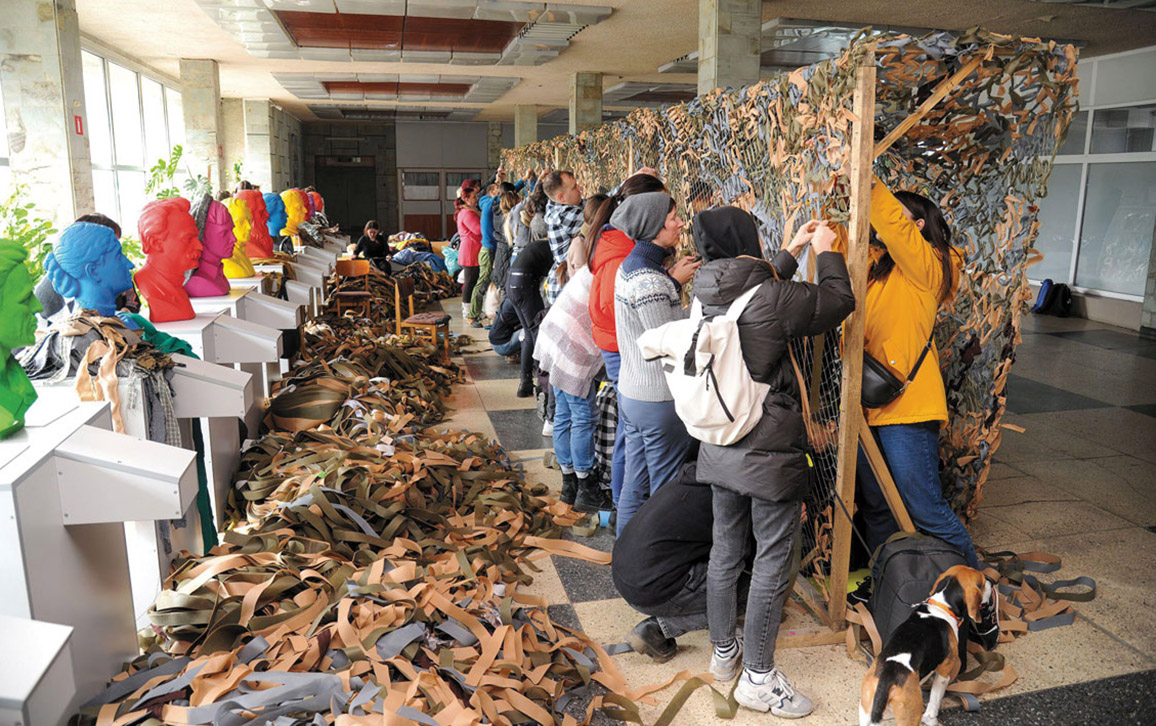
© Mykola Tys/SOPA Images via ZUMA Press Wire/Alamy Stock Photo
One group of volunteers from universities worldwide has launched the #ScienceForUkraine initiative to support scientists and students of Ukrainian academic institutions. Sanita Reinsone, a digital humanities researcher at the University of Latvia, Riga, is coordinating these efforts. “Ukrainian scholars don’t have the time to search these offers individually, so we want to aggregate all the details in one place,” she told Nature in March. The #ScienceForUkraine website lists opportunities at university, national, and international levels that will allow students and researchers to carry on their academic work. The website also includes details on how institutions and individuals can support the initiative.
The Ukrainian academic community believes that it is currently impossible to cooperate with Russian educational and research agencies and universities at the systemic and institutional levels. Doing so would violate our academic values and freedoms. Free academic dialogue and unbiased discussions with Russian institutions that follow the state’s propaganda are impossible, because freedom of speech, research, free teaching, and learning are being impeded. Ukrainian scientists call on the international academic community to fight for academic values and responsible science, and for a peaceful and stable future for the whole world.
Many in the global academic and research community have condemned Russia’s aggression against Ukraine. In the United States, the Massachusetts Institute of Technology (MIT), for example, has ended its relationship with the Skolkovo Institute of Science and Technology (Skoltech) in Moscow. “This step is a rejection of the actions of the Russian government in Ukraine,” reads a February 25 statement from MIT.
Similarly, the University of Tübingen, Germany, has joined scholars and scientists from around the world in strongly condemning the Russian attack on Ukraine. “We are horrified and deeply concerned about what is happening in Kyiv and the whole country and will support students as well as researchers in need,” said Monique Scheer, the university’s vice president for international affairs. With this expression of solidarity, the university’s leadership has joined with the European university alliance CIVIS to reaffirm their institutions’ commitment to respect for human dignity, freedom of opinion and speech, and freedom of science and research. The University of Tübingen has set up an emergency fund with research fellowships to support Ukrainian researchers at risk.
Fifteen of the world’s largest publishers of scientific journals, including Elsevier and Springer Nature, have condemned Russia’s invasion of Ukraine and have called for an end to the aggression. “We have taken the unprecedented step of suspending sales and marketing of products and services to research organisations in Russia and Belarus,” the publishers wrote in a joint public statement on March 31. “We are working to aid affected colleagues and contractors, while contributing to broader relief efforts that are providing safety and support for those in peril including Ukrainian researchers.”
Ukrainian science is suffering irreparable losses. The cruel truth of the Russian war against Ukraine is that many of Ukraine’s best and brightest are dying. Current and future scientists, researchers, educators, students, and university graduates are dying—those who could create a successful and prosperous Ukraine. Some scientists are considered missing.
When Viazovska accepted the Fields Medal on July 5 in Helsinki, she mourned these losses. A commemorative video at the ceremony showed another Ukrainian mathematician, 21-year-old Yulia Zdanovska, who was a teacher, volunteer, laureate of the all-Ukrainian and International Olympiads in computer science and mathematics, winner of the European Mathematical Olympiad among girls, and a graduate of the faculty of mechanics and mathematics at Taras Shevchenko National University of Kyiv. Zdanovska died tragically during a Russian missile attack on her home city of Kharkiv on March 3.
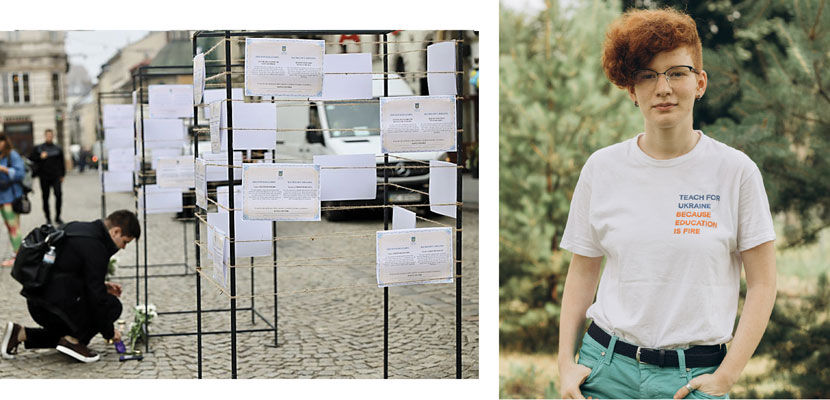
2022 © Lviv City Council. Reprinted with the permission of the Lviv City Council/CC BY-NC-ND 3.0; Teach for Ukraine
Zdanovska has become a symbol of the many talented and promising Ukrainian people who have been killed. Her dream was to teach mathematics. She could have mentored a new generation of scientists and educators. Zdanovska was predicted to have a great scientific future. Oksana Bezushchak, dean of the faculty at Taras Shevchenko National University, told the Association for Computing Machinery that Zdanovska “was not only extremely talented, but had a fantastic, life-affirming energy. . . . [She] was our mathematical sunshine, our hope, but is our unspeakable pain now.” Zdanovska had so much to offer her country and the world. But none of these achievements will come to pass.
In memory of Zdanovska, the department of mathematics at MIT has organized a free math enrichment and research program called Yulia’s Dream for the most talented high school students from Ukraine.
A vigil, “Diplomas That Will Never Be Issued,” was held in August in Lviv in memory of the students who have died during the Russian invasion. Forty diplomas for students from all over Ukraine who died in the struggle for the country’s independence were displayed in the central square of the city. Their names are indicated on the diplomas. Tragically, the list of the dead remains incomplete, because the war continues and the future is uncertain.
As we mourn these losses to the global scientific community, we can each do our part to secure a better future—without wars, death, and destruction, but with peace, humanity, and happiness.
Click "American Scientist" to access home page
American Scientist Comments and Discussion
To discuss our articles or comment on them, please share them and tag American Scientist on social media platforms. Here are links to our profiles on Twitter, Facebook, and LinkedIn.
If we re-share your post, we will moderate comments/discussion following our comments policy.